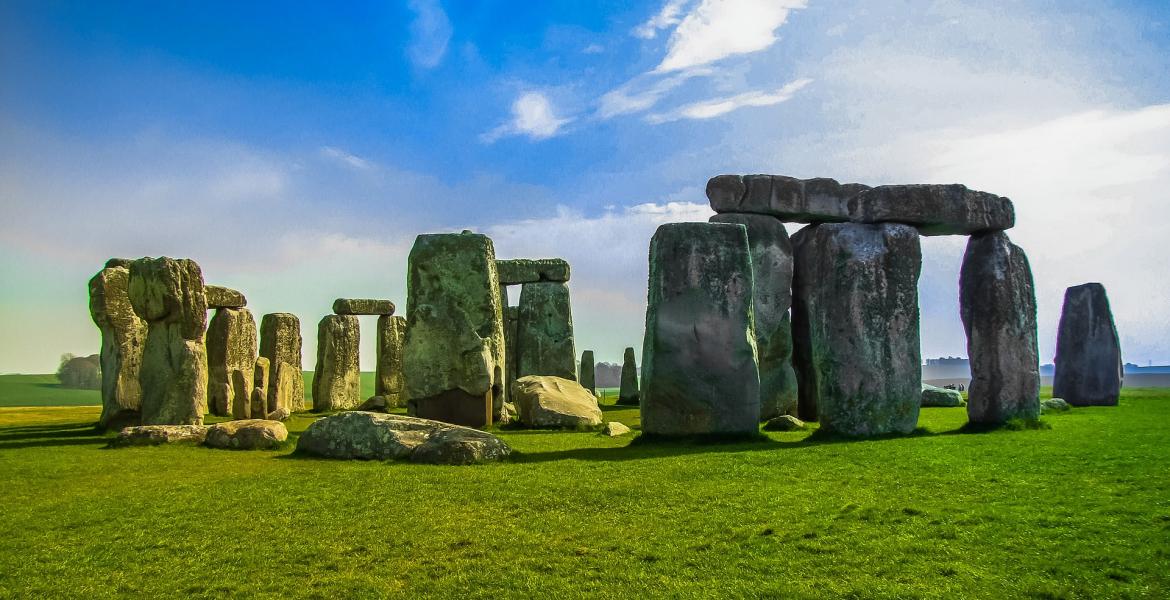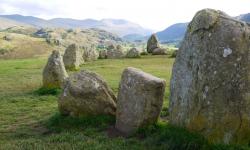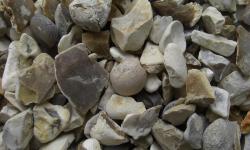Stonehenge: Trying to Understand the Mystery
Key facts about Stonehenge
- The area around Stonehenge has been in use for 10,000 years
- The actual stone circle is just a small part of the Stonehenge landscape
- We still don't know how Stonehenge was built
- We still don't know what it was used for, although ritual and social gatherings seem likely
People you need to know
- Aurelius Ambrosius - a semi-legendary fifth century British king, who won against the Anglo-Saxons. He came to be known as King Arthur's uncle.
- Hengist - an Anglo-Saxon warrior who came to Britain as a mercenaryA professional soldier hired to serve in a foreign army.A professional soldier hired to serve in a foreign army.A professional soldier hired to serve in a foreign army.A professional soldier hired to serve in a foreign army. and went on to settle there.
 It's difficult to discover the real history behind the stories told by the likes of Bede. Many Anglo-Saxon sources record him and his brother, Horsa, conquering and causing havoc, although historians are now questioning the truth of this.
It's difficult to discover the real history behind the stories told by the likes of Bede. Many Anglo-Saxon sources record him and his brother, Horsa, conquering and causing havoc, although historians are now questioning the truth of this. - Henry of Huntingdon - twelfth century historian and Archdeacon of Huntingdon.
- Merlin - legendary magician who is supposed to have aided King Arthur.
- Geoffrey of Monmouth - twelfth century Welsh cleric and chronicler, who wrote extensively about the kings of England and King Arthur.
- Diodorus Siculus - first century BCE'Before common era', the non-religious way of saying 'BC' (which means 'before Christ').'Before common era', the non-religious way of saying 'BC' (which means 'before Christ').'Before common era', the non-religious way of saying 'BC' (which means 'before Christ').'Before common era', the non-religious way of saying 'BC' (which means 'before Christ'). Sicilian Greek historian.
- William Stukeley - eighteenth century clergyman, antiquarianSomeone who is interested in, or collects, antiques and antiquities.Someone who is interested in, or collects, antiques and antiquities.Someone who is interested in, or collects, antiques and antiquities.Someone who is interested in, or collects, antiques and antiquities. and pioneer archaeologist.
- Uther Pendragon - legendary king and father of King Arthur.
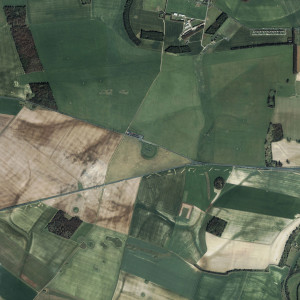
Stonehenge is a famous, but little understood, stone circle just outside Amesbury in Wiltshire. It is also more than just a stone circle, with a ritual landscape spreading out from it in every direction. Within this landscape, there are a number of other earthworksEmbankments or other constructions made of earth.Embankments or other constructions made of earth.Embankments or other constructions made of earth.Embankments or other constructions made of earth., cursusesThe name given to the large parallel lengths of banks with external ditches, which at one time were believed to be Roman athletic courses.The name given to the large parallel lengths of banks with external ditches, which at one time were believed to be Roman athletic courses.The name given to the large parallel lengths of banks with external ditches, which at one time were believed to be Roman athletic courses.The name given to the large parallel lengths of banks with external ditches, which at one time were believed to be Roman athletic courses., timber circles, hengesNwolithic earthworks with a ring bank and ditch, with the ditch inside the bank rather than outside.Nwolithic earthworks with a ring bank and ditch, with the ditch inside the bank rather than outside.Nwolithic earthworks with a ring bank and ditch, with the ditch inside the bank rather than outside.Nwolithic earthworks with a ring bank and ditch, with the ditch inside the bank rather than outside., ditches, and long and round barrowsRound earth and/or stone works raised over a burial. They started occurring in the Neolithic and were very common in the early Bronze Age. They continued to be built up to and including Anglo-Saxon times.Round earth and/or stone works raised over a burial. They started occurring in the NeolithicThe 'New Stone Age'. See 'The Chronology of the Stone Age'. and were very common in the early Bronze AgeThe Bronze Age was a time between the Neolithic and the Iron Age, which is characterised by the use of the alloy bronze. In Britain it lasted from about 2500BCE until about 800BCE.. They continued to be built up to and including Anglo-Saxon times.Round earth and/or stone works raised over a burial. They started occurring in the NeolithicThe 'New Stone AgeThe earliest part of human prehistory, running from about 3.3 million years ago until (in Britain) about 2500BCE. It is defined by the use of stones (rather than metals) as tools.'. See 'The ChronologyThe arranging of events in the order they occurred in time. of the Stone Age'. and were very common in the early Bronze AgeThe Bronze Age was a time between the Neolithic and the Iron AgeThe Iron Age of the British Isles covers the period from about 800BCE to the Roman invasion of 43CE, and follows on from the Bronze Age., which is characterised by the use of the alloy bronze. In Britain it lasted from about 2500BCE until about 800BCE.. They continued to be built up to and including Anglo-Saxon times.Round earth and/or stone works raised over a burial. They started occurring in the NeolithicThe 'New Stone AgeThe earliest part of human prehistoryThe time in the past that happened before history began to be recorded., running from about 3.3 million years ago until (in Britain) about 2500BCE. It is defined by the use of stones (rather than metals) as tools.'. See 'The ChronologyThe arranging of events in the order they occurred in time. of the Stone Age'. and were very common in the early Bronze AgeThe Bronze Age was a time between the Neolithic and the Iron AgeThe Iron Age of the British Isles covers the period from about 800BCE to the Roman invasion of 43CE, and follows on from the Bronze Age., which is characterised by the use of the alloy bronze. In Britain it lasted from about 2500BCE until about 800BCE.. They continued to be built up to and including Anglo-Saxon times.. Although it is known around the world, and is a UNESCOUnited Nations Educational, Scientific and Cultural Organisation.United Nations Educational, Scientific and Cultural Organisation.United Nations Educational, Scientific and Cultural Organisation.United Nations Educational, Scientific and Cultural Organisation. world heritage site, no-one really knows who built it, why they built it, how they built it, or what it was used for. Nor do we know whether this changed over time. What we do know is that the area around Stonehenge has been used for a very long time. We also know that it took a long time and a lot of hard work to build it. It must have been important. But why?
Stonehenge in the MesolithicThe 'Middle Stone Age'. See 'The Chronology of the Stone Age'.The 'Middle Stone Age'. See 'The Chronology of the Stone Age'.The 'Middle Stone Age'. See 'The Chronology of the Stone Age'.The 'Middle Stone AgeThe earliest part of human prehistoryThe time in the past that happened before history began to be recorded., running from about 3.3 million years ago until (in Britain) about 2500BCE. It is defined by the use of stones (rather than metals) as tools.'. See 'The ChronologyThe arranging of events in the order they occurred in time. of the Stone Age'.
Prehistorians used to think Stonehenge started being used at the very end of the NeolithicThe 'New Stone Age'. See 'The Chronology of the Stone Age'., somewhere between 3000 BCE and 2500 BCE. However, recent discoveries have pushed this date back by several thousand years. At some point in the Mesolithic, as the ice retreated and warm days - and therefore plants and animals - returned, weathering and soil accumulation worked to turn some naturally occurring cracks in the chalk of Salisbury Plain into something deeply special. As a team of archaeologists rediscovered in 2008, these natural cracks align perfectly with the NE-SW direction of the Avenue in the Stonehenge landscape, and of the rising and setting of the sun at the solstices. It is likely that the first people to walk across Salisbury Plain after the last ice ageA time when it was very cold and glaciers extended down from the North Pole. See 'A Brief History of Climate Change'. not only noticed this alignment, but also the way plants filled the lines of dark soil that collected in the fissures, coming to life in summertime and becoming dark and bare in winter. This symbolism likely helped to inspire, and then cement, the idea of the Stonehenge landscape as special. See Francis Pryor, Scenes from Prehistoric Life (London: Head of Zeus, 2021), pp. 57-74.
See Francis Pryor, Scenes from Prehistoric Life (London: Head of Zeus, 2021), pp. 57-74.
Just two miles to the east of Stonehenge, there is evidence of considerable, sustained habitation at Blick Mead from about 8000 to perhaps 4000 BCE. By 2018, over 30,000 worked flints have been found at the site, along with fragments of animal bones from megafaunaLarge, and now mainly extinct, animals that lived during the Palaeolithic, such as woolly mammoths and sabre-toothed cats.Large, and now mainly extinct, animals that lived during the PalaeolithicThe 'Old Stone Age'. See 'The Chronology of the Stone Age'., such as woolly mammoths and sabre-toothed cats. like aurochs. Ibid, p. 66. The beauty of this site is not just the fact that it has remained relatively undisturbed for millenniaThousands of years.Thousands of years., preserving much more than is often the case, but that it lends weight to theories about the social and community lives of Mesolithic hunter-gatherers. That aurochs were hunted - when the carcass of one could feed hundreds - suggests there were big meetings at Blick Mead, and this is supported by specific finds that came from all over Britain, including from Kent and Yorkshire.
Ibid, p. 66. The beauty of this site is not just the fact that it has remained relatively undisturbed for millenniaThousands of years.Thousands of years., preserving much more than is often the case, but that it lends weight to theories about the social and community lives of Mesolithic hunter-gatherers. That aurochs were hunted - when the carcass of one could feed hundreds - suggests there were big meetings at Blick Mead, and this is supported by specific finds that came from all over Britain, including from Kent and Yorkshire.
Three or four very large postholes have been found in the old visitor car-park, which, thanks to carbon dating and pollen analysis, have been dated to somewhere between 8500 BCE and 7650 BCE. These postholes, spaced 10-14m apart in a woodland clearing, show that the pine tree trunks (oak had not yet come back to Britain) placed within them would have been very large. Each hole was almost a metre wide, and over a metre deep. Although archaeologists tend to say things were used for ritual and ceremony when they don’t understand them, these postholes suggest that the area had spiritual importance as far back as the Mesolithic. We can say there was continuity in the use of the site through to the Neolithic and later, which might also suggest continuity of people.
These postholes, spaced 10-14m apart in a woodland clearing, show that the pine tree trunks (oak had not yet come back to Britain) placed within them would have been very large. Each hole was almost a metre wide, and over a metre deep. Although archaeologists tend to say things were used for ritual and ceremony when they don’t understand them, these postholes suggest that the area had spiritual importance as far back as the Mesolithic. We can say there was continuity in the use of the site through to the Neolithic and later, which might also suggest continuity of people. Amesbury is now the area with the longest continuous settlement in the UK, following the discovery of cooked frogs’ legs dating to 8800 BCE (8,000 years before the French ate them!). This continuous settlement and use goes against the theory that there were waves of conquering peoples, first at the start of the Neolithic and then at the end (the Beaker peoples), who brought their own customs and practices and which, therefore, radically changed the ethnic makeup and cultures of those living in Britain. However, it must also be remembered that other invaders, such as the Romans, were usually respectful of the gods, beliefs and customs of their provinces (unless they were directly threatened by them, such as with the DruidsThe name given to priests of an Iron Age system of beliefs in Britain and Gaul.The name given to priests of an Iron Age system of beliefs in Britain and GaulAn ancient region covering much of western Europe, including France, Belgium, Luxembourg, and parts of Switzerland, the Netherlands, Germany and northern Italy..The name given to priests of an Iron Age system of beliefs in Britain and GaulAn ancient region covering much of western Europe, including France, Belgium, Luxembourg, and parts of Switzerland, the Netherlands, Germany and northern Italy..The name given to priests of an Iron AgeThe Iron Age of the British Isles covers the period from about 800BCE to the Roman invasion of 43CE, and follows on from the Bronze Age. system of beliefs in Britain and GaulAn ancient region covering much of western Europe, including France, Belgium, Luxembourg, and parts of Switzerland, the Netherlands, Germany and northern Italy..), and the continued use of the site on its own does not guarantee continuity of people. It also shows that spirituality in the Mesolithic was developed and organised enough to build a monument.
Amesbury is now the area with the longest continuous settlement in the UK, following the discovery of cooked frogs’ legs dating to 8800 BCE (8,000 years before the French ate them!). This continuous settlement and use goes against the theory that there were waves of conquering peoples, first at the start of the Neolithic and then at the end (the Beaker peoples), who brought their own customs and practices and which, therefore, radically changed the ethnic makeup and cultures of those living in Britain. However, it must also be remembered that other invaders, such as the Romans, were usually respectful of the gods, beliefs and customs of their provinces (unless they were directly threatened by them, such as with the DruidsThe name given to priests of an Iron Age system of beliefs in Britain and Gaul.The name given to priests of an Iron Age system of beliefs in Britain and GaulAn ancient region covering much of western Europe, including France, Belgium, Luxembourg, and parts of Switzerland, the Netherlands, Germany and northern Italy..The name given to priests of an Iron Age system of beliefs in Britain and GaulAn ancient region covering much of western Europe, including France, Belgium, Luxembourg, and parts of Switzerland, the Netherlands, Germany and northern Italy..The name given to priests of an Iron AgeThe Iron Age of the British Isles covers the period from about 800BCE to the Roman invasion of 43CE, and follows on from the Bronze Age. system of beliefs in Britain and GaulAn ancient region covering much of western Europe, including France, Belgium, Luxembourg, and parts of Switzerland, the Netherlands, Germany and northern Italy..), and the continued use of the site on its own does not guarantee continuity of people. It also shows that spirituality in the Mesolithic was developed and organised enough to build a monument.
Stonehenge in the Neolithic and Early Bronze AgeThe Bronze Age was a time between the Neolithic and the Iron Age, which is characterised by the use of the alloy bronze. In Britain it lasted from about 2500BCE until about 800BCE.
The Stonehenge we know today started as a circular earthwork enclosure, dug about 2950 BCE, with a circle of pits just inside the bank. They are known as Aubrey Holes, after the archaeologist who found them, and it has been proposed that at one point they held the bluestonesA convenient label for the smaller stones found at Stonehenge, that aren't all of the same rock.A convenient label for the smaller stones found at Stonehenge, that aren't all of the same rock.A convenient label for the smaller stones found at Stonehenge, that aren't all of the same rock.A convenient label for the smaller stones found at Stonehenge, that aren't all of the same rock.. Cattle skulls and jaws found by the entrances are at least two centuries older than the circle, suggesting they were moved from elsewhere and were important.
They are known as Aubrey Holes, after the archaeologist who found them, and it has been proposed that at one point they held the bluestonesA convenient label for the smaller stones found at Stonehenge, that aren't all of the same rock.A convenient label for the smaller stones found at Stonehenge, that aren't all of the same rock.A convenient label for the smaller stones found at Stonehenge, that aren't all of the same rock.A convenient label for the smaller stones found at Stonehenge, that aren't all of the same rock.. Cattle skulls and jaws found by the entrances are at least two centuries older than the circle, suggesting they were moved from elsewhere and were important.
The henge and circle went through a number of stages of remodelling following the first phase. At some point before any stones arrived, wood was used to form a circle. BluestonesA convenient label for the smaller stones found at Stonehenge, that aren't all of the same rock.A convenient label for the smaller stones found at Stonehenge, that aren't all of the same rock.A convenient label for the smaller stones found at Stonehenge, that aren't all of the same rock., which stood upright, were set in an arc in the centre of the enclosure a couple of centuries later, At roughly the same time as the arrival of the stones, the wooden monuments of Woodhenge, Coneybury Henge and Durrington Walls, were built in the surrounding area. Was this to replace the wood from Stonehenge, and does it show a shift in the use of Stonehenge? Were there different properties associated with wood and stone? Francis Pryor suggests that wood was associated with life (having come from trees and therefore having been alive) and stone associated with death. before they were remodelled
At roughly the same time as the arrival of the stones, the wooden monuments of Woodhenge, Coneybury Henge and Durrington Walls, were built in the surrounding area. Was this to replace the wood from Stonehenge, and does it show a shift in the use of Stonehenge? Were there different properties associated with wood and stone? Francis Pryor suggests that wood was associated with life (having come from trees and therefore having been alive) and stone associated with death. before they were remodelled About half the stones are now missing, and we used to wonder whether they had ever existed, whether it was done on purpose or whether it had simply never been finished. But the very dry weather over the summer of 2014 showed the places where stones used to be, confirming that it did indeed used to be a perfect circle. and the famous sarsensThe large stones at Stonehenge, which have come from local sandstone quarries.The large stones at Stonehenge, which have come from local sandstone quarries.The large stones at Stonehenge, which have come from local sandstone quarries.The large stones at Stonehenge, which have come from local sandstone quarries. added to Stonehenge around 2500 BCE.
About half the stones are now missing, and we used to wonder whether they had ever existed, whether it was done on purpose or whether it had simply never been finished. But the very dry weather over the summer of 2014 showed the places where stones used to be, confirming that it did indeed used to be a perfect circle. and the famous sarsensThe large stones at Stonehenge, which have come from local sandstone quarries.The large stones at Stonehenge, which have come from local sandstone quarries.The large stones at Stonehenge, which have come from local sandstone quarries.The large stones at Stonehenge, which have come from local sandstone quarries. added to Stonehenge around 2500 BCE.
Stonehenge since the Bronze Age
Stonehenge continued to be built and rebuilt until at least 1500 BCE. A further five stages of development have been identified after the sarsens were added. This shows that it was still important within the community, and still in use. The monument is often linked with the Druids (the name given to people practising an Iron AgeThe Iron Age of the British Isles covers the period from about 800BCE to the Roman invasion of 43CE, and follows on from the Bronze Age. system of beliefs), although they came after it was built.
A further five stages of development have been identified after the sarsens were added. This shows that it was still important within the community, and still in use. The monument is often linked with the Druids (the name given to people practising an Iron AgeThe Iron Age of the British Isles covers the period from about 800BCE to the Roman invasion of 43CE, and follows on from the Bronze Age. system of beliefs), although they came after it was built. Some of this association might be to do with William Stukeley, who undertook a close study of Stonehenge in the mid-18th century. He was searching for an ancient British Druidism, whose civilisation and learning could rival that of the Romans or Greeks. But this doesn't mean they didn't use it, and Iron Age finds around the site suggest that they were aware of it. Some think there are references to Stonehenge in classical texts, particularly one written by the Sicilian Greek historian Diodorus Siculus, who wrote in the first century BCE. Basing his comments on earlier, and now lost, texts, Siculus mentions a temple shaped like a ball in which Apollo was worshipped.
Some of this association might be to do with William Stukeley, who undertook a close study of Stonehenge in the mid-18th century. He was searching for an ancient British Druidism, whose civilisation and learning could rival that of the Romans or Greeks. But this doesn't mean they didn't use it, and Iron Age finds around the site suggest that they were aware of it. Some think there are references to Stonehenge in classical texts, particularly one written by the Sicilian Greek historian Diodorus Siculus, who wrote in the first century BCE. Basing his comments on earlier, and now lost, texts, Siculus mentions a temple shaped like a ball in which Apollo was worshipped.
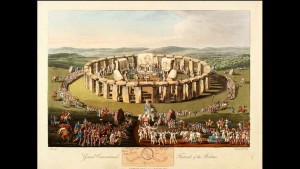
The first time Stonehenge was definitely recorded in writing was as one of the four wonders of England in the twelfth century by Henry, Archdeacon of Huntingdon. Writing in the same century as Henry of Huntingdon, Geoffrey of Monmouth, the famous chronicler, weaved Stonehenge into his magical story of Britain. He said that it was built by the fifth century kings Aurelius Ambrosius and Uther Pendragon with the help of Merlin to commemorate British nobles killed by Hengist and the Saxons. This story, with varying degrees of scepticism, was taken up by authors until the Stuart era, and the first recorded tourist visit took place in 1562. By the seventeenth and eighteenth centuries, several more scientific approaches were published, most notably by William Stukeley in 1740, when it became associated with the Druids and later with human sacrifice. It remained in private hands until it was bought at auction in September 1915 by a Mr Chubb for £6,000 as a gift for his wife. His wife didn't want it, so he gifted it to the nation. Since then, it has been ‘restored’ by government and charitable organisations, and the Stonehenge we now see as we drive down the A303 isn't what we would have seen 100 years ago. Access to it remains in question, and it is often under threat from building projects and roadworks. The latest threat is the proposed tunnel for the A303, which could seriously disturb the landscape.
The latest threat is the proposed tunnel for the A303, which could seriously disturb the landscape.
How was Stonehenge built?
The large sarsen stones, weighing up to 45 tons each, were quarried 18 miles from Stonehenge, in the Marlborough Downs. While the quarrying and transporting of these stones is impressive, they do not provide the riddle that the bluestones present. These bluestones, each weighing between two and three tons, come from the Preseli Hills in Pembrokeshire, Wales, about 160 miles from Stonehenge. As does the altar stone, which is made from sandstone but its exact source hasn't yet been pinpointed. Cunliffe has suggested that they may have belonged to an earlier stone circle in Wales, and that the whole circle was, in effect, moved. So, one big question about Stonehenge is ‘how did the stones even get there?’
As does the altar stone, which is made from sandstone but its exact source hasn't yet been pinpointed. Cunliffe has suggested that they may have belonged to an earlier stone circle in Wales, and that the whole circle was, in effect, moved. So, one big question about Stonehenge is ‘how did the stones even get there?’
Human transportation theory
The most appealing idea is that the stones were sourced from the Preseli Hills by people with a vision for Stonehenge, and the thought that the bluestones were brought such a distance by human hand adds to the magic and mystery of the place.
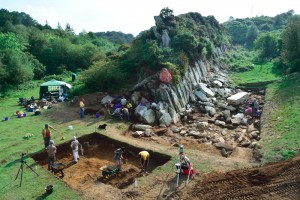
When Stonehenge was built, transport across land was difficult and limited to foot. It’s a matter of debate as to when wild horses were tamed. It is possible they were being domesticated in Britain by the time the sarsens were added, although wheeled transport would not have been available. Limited technology – including the lack of wheeled transport – presented huge problems in the transportation of heavy items, and it would have been almost impossible to carry such weights over long distances by land. The other option would have been transport by boat. So, were the stones loaded onto rafts on the South Wales coast, taken along the coast of Wales and then up the Bristol Channel, followed by a journey along the narrow rivers of the Wylie and the Avon, then taken two miles across land?
It’s a matter of debate as to when wild horses were tamed. It is possible they were being domesticated in Britain by the time the sarsens were added, although wheeled transport would not have been available. Limited technology – including the lack of wheeled transport – presented huge problems in the transportation of heavy items, and it would have been almost impossible to carry such weights over long distances by land. The other option would have been transport by boat. So, were the stones loaded onto rafts on the South Wales coast, taken along the coast of Wales and then up the Bristol Channel, followed by a journey along the narrow rivers of the Wylie and the Avon, then taken two miles across land?
Aubrey Burl has suggested that the inhabitants of landlocked Wiltshire probably weren't capable of taking such a difficult journey by sea. Originally, the site of the stones was thought to be on the side of the hills closest to the sea, which would have made it easier to transport them downhill to the Pembrokeshire coast. However, new work using chemical analyses has shown that the actual site of most of the stones is on the landwards side of the hills. Not only, then, would people have had to transport them to Wiltshire, but they would also have had to drag them up and down the Preseli Hills. The problems with this situation have led people, such as Geoffrey of Monmouth, to suggest that they were moved by magic.
However, as Francis Pryor has pointed out, pondering the technicalities of moving the stones might, in fact, be missing the bigger picture. The stones were special and the very act of moving them was also significant. Difficulty might not, therefore, have been a deterrent: in more recent times, people have willingly undertaken long and hazardous journeys on pilgrimage, so why should this be any different? Ease of transportation was not necessarily the primary concern. Recent fieldwork has backed this theory up. It now seems that the stones had once formed a stone circle in Wales, and they were painstakingly moved overland to be reconstructed on Salisbury Plain. They already had a special significance, and this is why they were used: convenience was not part of the equation. Pryor, Scenes, pp. 57-74.Geoffrey of Monmouth suggested Merlin had moved them. Of course, if Merlin had ever existed, then it was likely to have been after the Romans left, and so his dates are out by almost 3,000 years!
Pryor, Scenes, pp. 57-74.Geoffrey of Monmouth suggested Merlin had moved them. Of course, if Merlin had ever existed, then it was likely to have been after the Romans left, and so his dates are out by almost 3,000 years!
Glacial erraticsLarge boulders carried sometimes hundreds of miles across land by ice.Large boulders carried sometimes hundreds of miles across land by ice.Large boulders carried sometimes hundreds of miles across land by ice.Large boulders carried sometimes hundreds of miles across land by ice.
GeologistsScientists who study the Earth.Scientists who study the Earth.Scientists who study the Earth.Scientists who study the Earth. have also questioned the human transportation theory and many think the stones were carried to Wiltshire as glacial erratics (large boulders carried sometimes hundreds of miles across land by ice). Most stone circles are made from stones found locally, so it would make sense for the same to be true of Stonehenge. This helps to explain why not all bluestones are the same (they are a mixture of different sorts of dolerites and other stones), and not all of them came from the same ‘quarry’ (although most did come from the Preseli Hills).
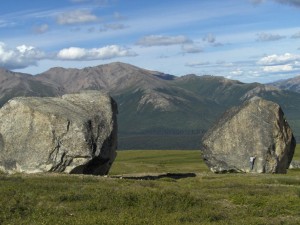
But the glacial erratic theory still presents some questions. We don’t know which glacierA large and dense body of ice which moves slowly under its own weight. It is made when the climate is cold and more snow falls in the winter than melts in the summer. See 'A Brief History of Climate Change'.A large and dense body of ice which moves slowly under its own weight. It is made when the climate is cold and more snow falls in the winter than melts in the summer. See 'A Brief History of Climate Change'.A large and dense body of ice which moves slowly under its own weight. It is made when the climate is cold and more snow falls in the winter than melts in the summer. See 'A Brief History of Climate Change'.A large and dense body of ice which moves slowly under its own weight. It is made when the climate is cold and more snow falls in the winter than melts in the summer. See 'A Brief History of Climate Change'. could have moved them – it is unlikely that it was during the Devensian ice ageThe last ice age experienced by Britain. It lasted from c.90000BP until 11600BP (or 9600BCE). See 'A Brief History of Climate Change'.The last ice age experienced by Britain. It lasted from c.90000BP until 11600BP (or 9600BCE). See 'A Brief History of Climate Change'.The last ice ageA time when it was very cold and glaciers extended down from the North Pole. See 'A Brief History of Climate Change'. experienced by Britain. It lasted from c.90000BP until 11600BP (or 9600BCE). See 'A Brief History of Climate Change'., as the last glacial maximumThe furthest extent (southwards) of the last ice sheet to cover Britain. See 'A Brief History of Climate Change'.The furthest extent (southwards) of the last ice sheet to cover Britain. See 'A Brief History of Climate Change'.The furthest extent (southwards) of the last ice sheet to cover Britain. See 'A Brief History of Climate Change'.The furthest extent (southwards) of the last ice sheet to cover Britain. See 'A Brief History of Climate Change'. (LGMThe furthest extent (southwards) of the last ice sheet to cover Britain. See 'A Brief History of Climate Change'.The furthest extent (southwards) of the last ice sheet to cover Britain. See 'A Brief History of Climate Change'.The furthest extent (southwards) of the last ice sheet to cover Britain. See 'A Brief History of Climate Change'.The furthest extent (southwards) of the last ice sheet to cover Britain. See 'A Brief History of Climate Change'.) didn't reach far enough south, and even the Anglian ice sheet may not have been enough. If the erratics were picked up by an Irish glacier, then why is the geographical origin of them not more widely spread, and why are there not more erratics in the area today? One place where the erratics could have been found was near Stanton Drew stone circle in Somerset, yet no erratics have been used in that circle. Also, the builders of Stonehenge have already shown they were willing to travel for the right stones by using those from the Marlborough Downs, 18 miles away. If people were willing to transport something weighing 45 tons for that distance, then surely they would be willing to transport something weighing just 5% of the sarsen stones a proportionately smaller distance? This is an argument that seems destined to continue, until definitive proof is found (if it ever will be). At the moment, the question seems to split archaeologists and geologistsScientists who study the Earth.Scientists who study the Earth.Scientists who study the Earth., although the latter are now helping archaeologists to search for quarries in the newly proposed area. Even if the geologists prove right, and the bluestones are erratics, the feat of moving both the sarsens and the bluestones, is still considerable.
Who built Stonehenge?
One thing the henge does tell us is about is the society that built it. Prehistorian Paul Bahn puts the time taken to build Stonehenge at 30 million man hours. It therefore must have been a community effort. It means the people who built it had time to spare, or at least could find the time, so their lives weren't taken up with subsistence and toil. Their farming systems were advanced enough to have the food surpluses to take time away from the fields, as well as to feed those working on Stonehenge. The community was also large enough to be able to put the manpower into building it, as this level of sourcing, transporting and building could not have been done by a small group alone. Some people have suggested that slaves were used. While we don’t know for sure, this seems unlikely: we already know that it was used as a focal point for the community, and this would probably have included the building of it. For such an important site, it would be unlikely for the organisers to entrust its building to those who were outside the community, and no evidence of slavery has been found at the site (such as slave chains). It used to be thought that the Egyptian pyramids were built by slave labour, which has now been disproven: the projects were too important and too complicated to be entrusted to slaves.
It used to be thought that the Egyptian pyramids were built by slave labour, which has now been disproven: the projects were too important and too complicated to be entrusted to slaves.
The other thing we know about the society that built Stonehenge is that they were organised. They could organise every aspect, including the actual people who built it. The task of finding, transporting and building the stone circle would be difficult even by today’s standards. A group of experimental archaeologists tried to transport just one stone using ‘traditional’ methods (they cheated a lot), and failed miserably. This has led many to believe there must have been a hierarchical society, with someone – or a group of people – at the top to direct the task. Whether this was a political or religious leader of the sort we have today, or whether it was a group of elders, or others, there must have been someone with the vision and capability to bring it to life. Furthermore, there must have been specialists, experts who knew about the sky, the stars, the movements of the sun and moon, as well as those who had a deep understanding of design and engineering. It was no ‘backwards’ society that built Stonehenge. Rather it was a well organised, expert, large group of individuals who had the knowledge and determination to complete the task.
A group of experimental archaeologists tried to transport just one stone using ‘traditional’ methods (they cheated a lot), and failed miserably. This has led many to believe there must have been a hierarchical society, with someone – or a group of people – at the top to direct the task. Whether this was a political or religious leader of the sort we have today, or whether it was a group of elders, or others, there must have been someone with the vision and capability to bring it to life. Furthermore, there must have been specialists, experts who knew about the sky, the stars, the movements of the sun and moon, as well as those who had a deep understanding of design and engineering. It was no ‘backwards’ society that built Stonehenge. Rather it was a well organised, expert, large group of individuals who had the knowledge and determination to complete the task.
What was the purpose of Stonehenge?
We still don’t know what Stonehenge was used for. Although we know certain things about the stones, which help us decide which uses are most likely, everything else is guesswork. As the area was in use for millenniaThousands of years.Thousands of years., it is possible that it had many different uses, and as the arrangement of the stones changed, so might their use.
Calendar
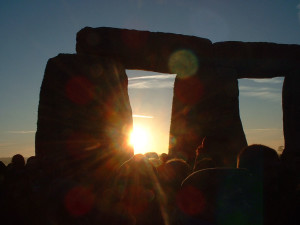
The sarsen stones line up with the setting sun on the winter solstice and the rising sun at summer solstice, and one of the thirty sarsen stones is narrower and shorter than the others. This gives a grand total of 29.3 sarsens, which is the number of solar days in a lunar month.
Given its alignment with the sun (and moon), Stonehenge could have been used as a sort of calendar. The place of the sun around the monument would show the time of year, and so it could be used to record the seasons and as a diary – the position of the sun could indicate when gatherings should happen, or when other processes should start or finish.
The exactness of this alignment would have taken considerable skill and knowledge as it was done without the aid of modern technology and measuring devices: it was made with the help of expert astronomers, who knew how to place the stones, and whose knowledge would have been gained over many years. Some people have even compared the builders of Stonehenge with those of the Egyptian pyramids. But not only were they master astronomers: they also had a deep understanding of geometry and design. The design of Stonehenge is so clever that some people have suggested it was used as a giant calculator, for dating eclipses and other astronomical events.
Religion
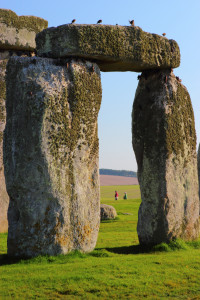
One of the most obvious suggestions is that it was a temple, or place of religious worship, with almost every prehistorian suggesting a range of ritual practices. It would certainly seem that the site has a history of religious and ritual use, with the discovery of the huge Mesolithic posts, which Mike Allen suggests were something similar to Native American totem poles, celebrating either the place or local people’s beliefs. Mike Parker Pearson has suggested that the stones were brought to Wiltshire to represent the ancestors of the people who built the monument, and that it was a temple to the history of the tribe. We know that other things – notably animal skulls – were taken to the site from elsewhere and reburied, which gives strength to the idea that it was used for honouring the past. However, a purely local focal point wouldn’t account for the distances that some travelled to reach the stones, the Amesbury Archer being the most obvious example. But by his time, perhaps the stones had changed in meaning and use. Timothy Darvill suggests that the five great sarsen trilithonsFrom the Greek, meaning 'three stones'. Megalithic structures consisting of two upright stones and a third across the top.From the Greek, meaning 'three stones'. Megalithic structures consisting of two upright stones and a third across the top.From the Greek, meaning 'three stones'. Megalithic structures consisting of two upright stones and a third across the top.From the Greek, meaning 'three stones'. Megalithic structures consisting of two upright stones and a third across the top. (each trilithon – meaning ‘three stones’ – being made of two uprights and one placed horizontally across the top) might have represented the gods of the time. The henge at nearby Durrington Walls also has five shrines, so he thinks that the number five was important. Religious belief during the Neolithic and Bronze Age seems to have focused on the sky and the seasons, and the alignment of the stones, as well as their size, could support the idea of a temple to the sky.
We know that other things – notably animal skulls – were taken to the site from elsewhere and reburied, which gives strength to the idea that it was used for honouring the past. However, a purely local focal point wouldn’t account for the distances that some travelled to reach the stones, the Amesbury Archer being the most obvious example. But by his time, perhaps the stones had changed in meaning and use. Timothy Darvill suggests that the five great sarsen trilithonsFrom the Greek, meaning 'three stones'. Megalithic structures consisting of two upright stones and a third across the top.From the Greek, meaning 'three stones'. Megalithic structures consisting of two upright stones and a third across the top.From the Greek, meaning 'three stones'. Megalithic structures consisting of two upright stones and a third across the top.From the Greek, meaning 'three stones'. Megalithic structures consisting of two upright stones and a third across the top. (each trilithon – meaning ‘three stones’ – being made of two uprights and one placed horizontally across the top) might have represented the gods of the time. The henge at nearby Durrington Walls also has five shrines, so he thinks that the number five was important. Religious belief during the Neolithic and Bronze Age seems to have focused on the sky and the seasons, and the alignment of the stones, as well as their size, could support the idea of a temple to the sky.
All of these theories might be true, or none of them. Spirituality could include worship of the ancestors, the land and nature, the sky, and magic such as healing. Worship of one wouldn’t exclude worship of the others. It is also likely that religious belief was not separate from other parts of daily life, as is often the case today, and Stonehenge may well have been important both spiritually and in other ways.
Healing
Timothy Darvill also suggests that Stonehenge started as a centre for healing. This is based on the (false) belief that the bluestones originally came from an area with natural springs (water is often associated with healing and with the gods), as well as the long-standing oral tradition which says the stones have healing properties. Pieces of the bluestones were chipped off and taken elsewhere almost from the moment they arrived at the site, suggesting that people wanted to take the healing properties of the stones with them. This could, however, easily be for another reason: wanting an amulet, perhaps, or as a sign that they belonged to a particular group, either geographically or through training or belief. Perhaps it was nothing as grand or symbolic: perhaps people just took pieces as a souvenir – rather like we take home souvenirs from places we’ve visited today. Whatever the reason for it, it would still show that the site was important enough for people to want to take bits of it away with them.
Burials
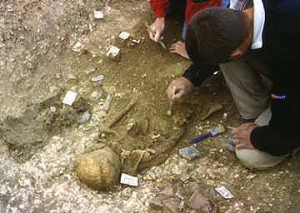
The idea of a centre for healing could explain the surrounding burials, of which there were many. Cremated bodies have been found dating to between c.3000-2500 BCE and burials continued at the site for centuries afterwards. The surrounding landscape is littered with both Neolithic long barrows and Bronze Age round barrows. Many of the 50 sets of older cremations found are of men, and Timothy Darvill thinks these may be the remains of an important line of people, such as rulers, shamans or medicine men.
Some of the burials are particularly interesting: the man known as the Amesbury Archer came from a long way away. Chemical analysis of his teeth shows that he was born in Bavaria, but eventually settled in the area. His bones show that he suffered injury: did he originally come to the area seeking a cure, or was there another reason for him, and others like him, to visit and maybe live in the area? Other remains came from even further away, including the Mediterranean. Perhaps the burials have less to do with any healing properties of the stones, and more to do either with religion or the community.
Other remains came from even further away, including the Mediterranean. Perhaps the burials have less to do with any healing properties of the stones, and more to do either with religion or the community.
Community life
Given that for one reason or another Stonehenge was important to those who built it and their descendants, it must also have had an important social function. What this included is, like all other things about Stonehenge, a guess. However, we do know that people gathered for feasting and for disposing of their dead. It might also have been used for healing and it was definitely used to mark important dates in the year. As such, it would have provided a focal point for a community and beyond, where societal and personal bonds would have been made, renewed and broken.
Things to think about
- Who was Stonehenge built and used by?
- How was Stonehenge built?
- What was the purpose of Stonehenge?
- How did the use of Stonehenge change over time?
Things to do
- Visit Stonehenge (entrance is free to English Heritage and National Trust members). You can find out more information about it here. See our review of it here.
- Stonehenge at Midsummer can be hectic, but if you want to enjoy the celebratory feel inside the stones it is open to the public at the winter solstice. English Heritage usually publishes details.
- Take a walk around the Stonehenge landscape. There are many books and maps for walking in the area, and best of all, walking doesn't cost anything!
- Keep up-to-date with the latest theories about, and finds from, Stonehenge by searching for it in news articles.
- Think how you would move the bluestones from the Preseli Hills to the Salisbury Plains. Try to plan the journey on a map, and remember that it's very difficult to go across dry land. What technology would you use to transport them? See how difficult it is to move a heavy object (like a book) across a flat surface on rollers (such as lengths of wooden dowel, which you can buy from places like ebay). What about transporting it uphill or downhill: what are the problems you encounter? Would there be a better way of moving something heavy across land?
Further reading
There's a huge number of books on Stonehenge, some of them good, many of them terrible. It can also be difficult to find books that are properly up-to-date, as new things are being discovered all the time. One of the most prolific authors on Stonehenge, who has spent a considerable time working in the Stonehenge landscape, is Mike Parker Pearson. A good, and recent, book is his Stonehenge: Exploring the greatest Stone AgeThe earliest part of human prehistoryThe time in the past that happened before history began to be recorded., running from about 3.3 million years ago until (in Britain) about 2500BCE. It is defined by the use of stones (rather than metals) as tools. mystery. Providing a different viewpoint, but sadly a bit outdated and technical, is Aubrey Burl's A Brief History of Stonehenge, part of the Brief Histories series.
- Log in to post comments


